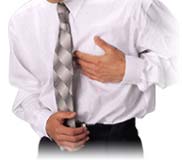The symptoms of angina or chest pain can be very alarming to alarming and may cause people to panic. Rather than just plain panicking, a little bit of knowledge and careful assessment is needed to be able to receive appropriate treatment. Any chest pain should be addressed and should not be neglected.
Angina Pectoris is a clinical syndrome or set of symptoms that is usually characterized by episodes of pain or pressure in front of the chest. It is named for the muscle anterior to the upper torso which is the Pectoralis muscle.
What Causes Chest Pain?
 Many people are aware that a chest pain should alarm the person experiencing it and seek medical attention. We all know that it should be treated. We are all afraid of heart attacks, don’t we? The question is: What causes the pain on the chest? The cause of pain is called ischemia, or lack of oxygen to the heart’s tissues. This is due to insufficient coronary arteries’ blood flow.
Many people are aware that a chest pain should alarm the person experiencing it and seek medical attention. We all know that it should be treated. We are all afraid of heart attacks, don’t we? The question is: What causes the pain on the chest? The cause of pain is called ischemia, or lack of oxygen to the heart’s tissues. This is due to insufficient coronary arteries’ blood flow.
The Law of Demand and Supply
The decreased oxygen supply of the blood circulating in the heart’s blood vessels or coronary arteries fail to meet the increased myocardial demand of oxygen in response to physical exertions or emotional stresses. This is the same reason why a person suffering angina episodes has increased fatigability with little exertion. The coronary arteries are the main suppliers of oxygenated blood in the heart’s tissues. Without it, the tissues of the heart will die and will predispose the person to a heart attack.
Physical exertions increase the myocardial oxygen demand. It makes the heart work harder to be able to pump blood and bring oxygenated blood to the organs of the body. How marvelous is the work of the heart.
Exposures to cold causes vasoconstriction, or the decrease in diameter size of the blood vessels, causing increased pressure to pump the blood. This leads to high blood pressure when measured using a sphygmomanometer. There is an increase in oxygen demand.
After eating a heavy meal, there is an increase in the blood flow to the mesenteric area for digestion of the food. This reduces the blood supply available to the heart muscle.
Stress, emotional disturbances, and provoking situations cause the release of adrenaline for fight or flight responses of the body. This results to increased blood pressure, increased heart rate, and increased myocardial workload of the heart.
Careful assessment of the person’s symptoms and activities, especially those that precede and precipitate attacks of angina pectoris. When these are established, it should be avoided at all costs. The quality, duration, severity of pain should also be established. Treatment of nitroglycerin involves evaluation of drug therapy reaction and effectiveness to the person.
Symptoms of Angina
The primary symptom of Angina Pectoris is chest pain. Pain symptoms vary in severity from a feeling of indigestion to a choking or heavy sensation in the upper chest that ranges from discomfort to agonizing pain. Also, pain is subjective and relative to the beholder. Different cultures, races, gender, etc. affect pain tolerance. Angina pain is often accompanied by severe anxiety and a feeling of an impending doom. The location of the pain is deep in the chest behind the upper or middle third of the sternum. Typically, pain and discomfort is poorly localized and may radiate to different parts adjacent to the chest such as the neck, jaw, shoulders, and inner aspect of the upper arms. More common to known is the left arm pain that is also often associated with a heart attack. Chest tightness, heavy choking sensation, strangling sensations, feelings of weakness or numbness in the arms, wrists and hands may also accompany the pain symptom of the chest. Shortness of breath is also a warrant sign. There can also be pallor and profuse sweating or diaphoresis. Dizziness and lightheadedness accompanied by nausea and vomiting are common symptoms. All of these symptoms may appear as alone, even without the primary symptom of chest pain. An important note is that the chest pain abates or subsides with nitroglycerin or rest.
For the elderly, typical symptoms of having chest pain may not be present but there may be shortness of breath. If there is pain on the chest, usually it is affecting both arms and may not only affect the left arm so it’s a case to case basis.
Treatment of the Symptoms

Nitroglycerin tablets are administered sublingually because it is a very potent drug that can dilate the coronary arteries.
Symptoms of angina can be treated with nitroglycerin. This causes the vasodilation of blood vessels to reduce myocardial oxygen consumption, thus decreasing oxygen demand. This decreases ischemia and therefore relieves the pain. Nitroglycerin dilates the veins but also the arteries in higher doses. When these are dilated, there is an increased blood flow to the coronary arteries.
Â
